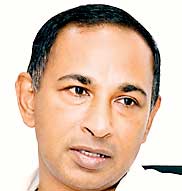Thursday Nov 14, 2024
Thursday Nov 14, 2024
Thursday, 11 February 2016 00:43 - - {{hitsCtrl.values.hits}}
 By Marianne David
By Marianne David
Sri Lanka’s fabric industry is positioning itself to emerge from the shadow of the apparel industry, sending a message to the global market that the country is gearing up to become a top fabric destination.
This repositioning of the industry comes in the backdrop of knitted fabrics manufacturer Textured Jersey – Sri Lanka’s only multinational mill – becoming the largest textile manufacturer in the region, post-acquisition of Quenby Lanka Prints Ltd. and Ocean India Ltd. as its subsidiaries in 2015.
“The fabric industry is emerging from the closet. For a Sri Lankan mill to reach this size and take the top slot is very interesting, especially given the competition from India,” asserted Textured Jersey Managing Director/Chief Executive Officer Sriyan de Silva Wijeyeratne, noting that this was a big boost for Sri Lanka’s local footprint. It will also mean that policymakers and the Government will need to put as much attention into the fabric industry as it does for the apparel industry, he said, in an interview with the Daily FT.
“Thus far Government attention has been largely apparel focused and I think we are in a phase where we will have to lead that awareness as we grow.”
Today the fabric industry in this country is bigger than some of the historical big local industries and is ahead of other key industries, de Silva Wijeyeratne revealed.
“It’s time to start establishing the strength of the fabric industry on its own merits. That’s why having a mul tinational presence suddenly sends a very different message to the market and to all the global players, saying Sri Lanka is starting to become interesting as a fabric destination as well,” he added.
“If we can give to the textile industry what MAS and Brandix gave to the apparel industry, we think the apparel industry’s $ 5-10 billion journey will be mirrored by a massive growth in this industry.”
TJL Group is presently the only one of its kind of this scale and sophistication in South Asia and has set its sights set on becoming a $ 300 million business by 2020.
Sri Lanka’s size certainly places it in an advantageous position. “Time to market drastically reduces when we have the supply chain sitting next door because our supply chain from mill to garment factory is a couple of hours from anywhere in the country. That’s a huge shift from saying you have to wait a few weeks to get fabric from China, for example,” affirmed de Silva Wijeyeratne.
Plans to introduce more sophisticated forms of printing will also change the dimensions of the country’s fabric industry and help it grow. “We have made some big investments in synthetic machinery, which will be operational in a couple of months. This brings a new dimension in the country which was not one of Sri Lanka’s strengths,” stated de Silva Wijeyeratne.
When the quota system was in place, Sri Lankan apparel got in purely on quota and produced whatever was available, but towards the era when the quota system was moving out, they had to move up the value chain and started innovating a lot more and getting more sophisticated, he said, noting that the industry survived because it moved up the value chain.
“In the fabric industry we would like to lead that charge in bringing new things like synthetic into the country on a big enough scale so it’s not about one player who can produce a little bit. Realistically, other mills will follow when we set the pace. That’s good for the industry and good for the country because we will need a certain critical mass for the country. A single mill can’t make a country impact. There are three to four good and strong players in the country already.”